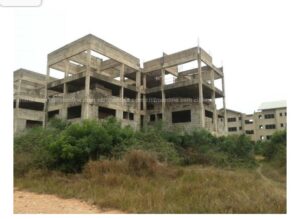Abandoned Government Projects Continue to Drain Ghana’s Resources and Deny Citizens Vital Infrastructure
 Ghana’s development journey is being stifled by a persistent problem: abandoned government projects. Across the country incomplete infrastructure initiatives—many launched with grand ceremonies and political promises—are now lying in disrepair overrun by weeds and dust. These failed projects represent a troubling waste of taxpayer money and a major setback in delivering essential services to communities.
Ghana’s development journey is being stifled by a persistent problem: abandoned government projects. Across the country incomplete infrastructure initiatives—many launched with grand ceremonies and political promises—are now lying in disrepair overrun by weeds and dust. These failed projects represent a troubling waste of taxpayer money and a major setback in delivering essential services to communities.
1. Saglemi Housing Project (Greater Accra Region)
One of the most high-profile examples is the Saglemi Affordable Housing Project which began in 2012 with the aim of delivering 5,000 housing units for low- to middle-income earners. Over a decade later only 668 units have been completed and remain uninhabited. The project was stalled due to alleged financial mismanagement and legal battles, leaving a partially completed housing estate as a symbol of inefficiency and lost opportunity.
2. Accra SkyTrain Project
In 2019, government officials signed a $2.6 billion agreement for an ambitious SkyTrain system to reduce traffic congestion in Accra. However, years later the project remains only on paper with no visible construction or progress made. Despite repeated assurances, the SkyTrain project has become another case of unrealized ambition.
3. Pwalugu Dam (Upper East Region)
Touted as a game-changer for agriculture and energy the Pwalugu Multi-Purpose Dam was expected to provide irrigation hydropower and flood control for the Northern regions. Costing $1 billion the project has stalled due to funding challenges despite a grand sod-cutting ceremony in 2019. Communities that were expecting transformation are left waiting in vain.
4. Agenda 111 Hospitals
Launched in 2021 the Agenda 111 initiative aimed to construct 111 district hospitals across the country to boost Ghana’s healthcare capacity. However, many of these sites remain incomplete with some abandoned entirely due to delays in funding, contractor issues, and lack of oversight. The slow progress has left many communities still without access to quality healthcare facilities.
5. Community Day Senior High Schools (E-Blocks)
Introduced under the Mahama administration, the Community Day SHS initiative planned to build 200 modern schools. While some were completed, dozens remain in limbo especially in underserved rural areas. Incomplete buildings now stand as neglected structures instead of vibrant centers of learning.
6. Abandoned KMA Projects (Ashanti Region)
The Kumasi Metropolitan Assembly (KMA) also suffers from a series of unfinished projects. These include classroom blocks libraries, and market structures. Many of these developments have stalled mid-way, depriving residents of much-needed services and economic opportunities.
7. Sunyani Regional Library and Science Park
In the Bono Region, two key education infrastructure projects—the Sunyani Regional Library and Science Park—have been left dormant. Initially designed to promote literacy and STEM education the projects have been neglected due to halted funding, denying youth access to innovation tools and academic resources.
8. Garu Hospital and Bolga-Bawku Road (Upper East Region)
Started under former President John Mahama, the Garu District Hospital and the Bolgatanga-Bawku Road were expected to boost health delivery and regional trade. Today, both projects show no significant progress, despite their critical importance to the people in the region.
These projects reflect a systemic issue of mismanagement, poor planning, and lack of continuity between successive governments. Political transitions often lead to stalled projects, with incoming administrations sidelining or ignoring initiatives launched by their predecessors.
Experts and civil society organizations are calling for stronger accountability frameworks, improved project monitoring and bipartisan commitment to national development plans—regardless of which party initiates them.
Until Ghana addresses this growing trend of project abandonment, the country risks falling further behind in its pursuit of sustainable development and inclusive growth.


